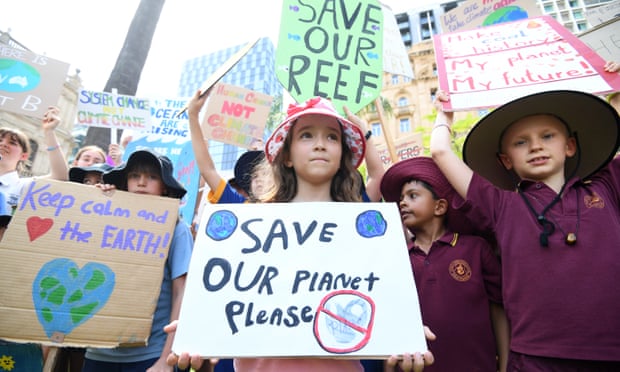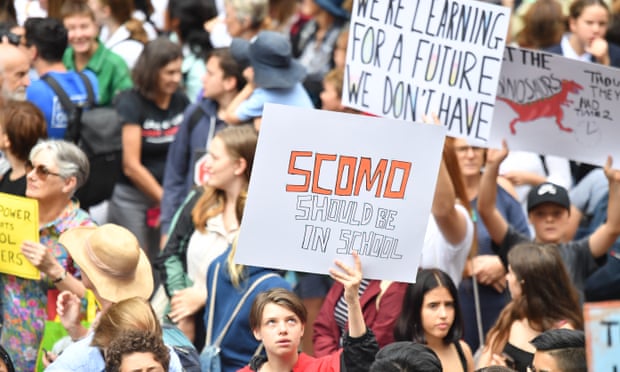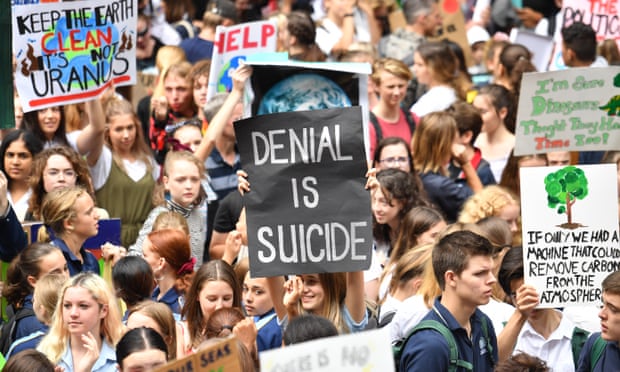Climate strike in Australia: everything you need to know about Friday’s protest
September 30, 2019 · By Lisa Cox for www.theguardian.com

The Friday 20 September climate strike will see school students in Australia rally in Melbourne, Sydney, Brisbane and across the country to call for climate change action as part of a global protest three days before a UN summit. Photograph: Dan Peled/AAP
Thousands of Australian school students are again preparing to walk out of classrooms across the country to demand action on the climate crisis.
The global mass day of action will take place on Friday 20 September, three days before the United Nations climate summit in New York.
It follows strikes in March this year in which 150,000 people marched in Australia and 1.5 million took part worldwide.
Organisers expect next week’s global strikes will be bigger and, this time there will be a much stronger presence from unions, workers and companies that have signed up to strike in solidarity with the young activists.
Here’s a guide to what’s happening.
Where will the strikes take place?
Strikes are planned in 120 countries across the world including almost 100 locations across Australia, from the major centres of Sydney and Melbourne to the small rural town of Wollar in New South Wales. There will be strikes in all capital cities and in regional centres such as Albury, Orange and Bendigo.
Organisers are anticipating the largest crowds this time will be in Melbourne, where the strikes coincide with the last day of the Victorian public school term.
“This massive day of action is going to be fundamental towards advocating for more efficient action on climate change,” Evan Meneses, a 17-year-old organiser for the Adelaide strike, said.
He said this was especially the case for Australia “given there is very little concrete evidence to suggest we’re achieving what was laid out in the Paris agreement”.
“There’s something that really connects with people when people as young as eight or 13 are advocating for action on the climate crisis because people that young are not the ones who should be having to [do so].”
The details for capital cities are as follows (all times are local).
Sydney 12 noon – The Domain
• Melbourne 2pm – Treasury Gardens
• Brisbane 1pm – Queens Gardens
• Canberra 12 noon –Glebe Park
• Adelaide 12 noon – Victoria Square
• Darwin 1pm – Parliament
• Perth 11am – Forrest Place
• Hobart 12 pm – Parliament
The full list of strike locations is here.
Who is going?
Organisers expect hundreds of thousands of people, including students and their parents, to take part.
The strikes will also have a strong presence from workers and unions. So far, 30 unions have signed up including the Australian Education Union, the Australian Nursing and Midwifery Federation and the CPSU.
Faith groups, including the Anglican and Uniting churches, have pledged their support for students. And hundreds of companies are giving staff time off to strike or finding other ways to express solidarity.

School students at the #ClimateStrike rally at Town Hall in Sydney in March. Photograph: Mick Tsikas/AAP
Last week companies including Atlassian, Future Super and KeepCup formed an alliance called Not Business as Usual that is urging businesses to support employees who want to strike. What began as an alliance of about 20 businesses has grown to almost 1,000 as of Friday afternoon.
Intrepid Travel is one of the companies giving employees a chance to participate in the strike.
Its chief executive, James Thornton, said: “We stand in solidarity to support the next generation as they demand climate action. It is real, it is happening and it’s time for global business leaders to do their part.”
What started this movement?
The students have been inspired by the Swedish school student Greta Thunberg, whose strikes outside the Swedish parliament sparked a global movement.
In November 2018, thousands of Australian school students went on strike and that was followed by the mass global day of action in March.
Thunberg is in New York for the UN climate summit after making a transatlantic trip on a zero emissions sailboat.
A youth summit, featuring some of the school strikers, including young Australian organisers, will take place in the lead-up to the UN conference.
What do the students want and how will these strikes differ to those in March?
The Australia students have three demands for governments.
1. No new coal, oil and gas projects, including the Adani mine.
2. 100% renewable energy generation and exports by 2030.
3. Fund a just transition and job creation for all fossil-fuel workers and communities.
The third point is a new feature for the Australian movement and particularly important for these strikes.
The strong presence of workers at these strikes is about trying to end the pitting of climate action and the needs of the economy against each other. Instead, the young activists want constructive action to support workers in carbon-intensive industries as economies transition to net zero emissions.
Alexa Stuart, a 15-year-old organiser of the Newcastle strike, said: “While it’s really important that we recognise that students are feeling scared about the impact of the climate crisis on our future, it’s also very important to recognise that, in Newcastle especially, there are a lot of jobs in the coalmining industry.
“Those jobs are the livelihoods of many people.
“It’s why it’s especially important that we’re starting to have conversations in the Hunter region about a just transition so no one is left behind and we can still have a positive impact on climate change.”

The #ClimateStrike rally at Town Hall in Sydney in March. Australian students are preparing to strike again at 100 locations across Australia. Photograph: Mick Tsikas/AAP
Varsha Yajman, 17, is a student at Gosford high school and an organiser of the Sydney strike. She said the federal election, at which the Coalition government was returned despite its lack of effective climate policy, had made the movement realise “we had to reach out to people beyond the student community”.
“With the election result, it became quite evident that a lot of people think our movement has just created instability for workers in the coal industry,” she said.
“A just transition for all workers is really, really important to us.
“We think a lot of teenagers are already aware of the impact of the climate crisis. We realised we need to reach out to adults and workers and demand their attention.”
Why are these strikes happening?
Young people are anxious about what their future looks like in a world that is failing to stall the climate crisis.
In the last week alone in Australia, bushfires have torn through Queensland and New South Wales in the first week of spring. They have been described as unprecedented.
Last summer brought a wave of natural disasters and record-breaking heat. For the first eight months of the year, the country’s mean temperature was the second warmest on record. Mean maximums were the warmest on record over the same period and mean minimums the equal-sixth warmest.
Authorities are warning of a grim outlook into the coming summer if current dry conditions and above average temperatures persist across much of the country.
Aoibhinn Crimmins, a 17-year-old student at Dickson College and an organiser of the Canberra strike, said the March strikes were designed as a “wake-up call” on climate ahead of the federal election.
“This strike is going to be much more about standing up in the face of adversity because the election result was not what we were expecting,” she said.
“We are going to the streets again showing we are not going to back down and we are going to keep fighting for climate justice.”






